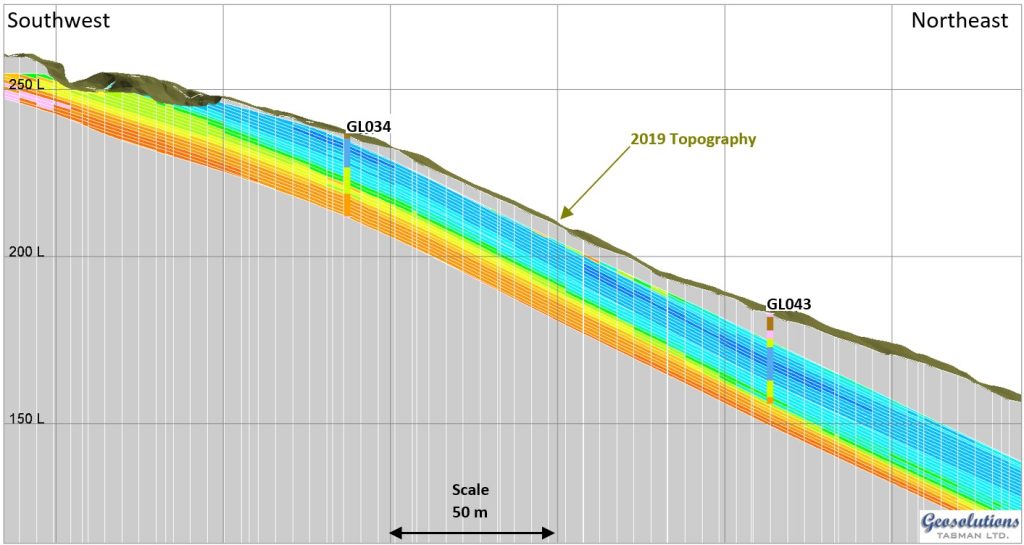March 2023 Issue Index
From challenge comes opportunity
For a New Zealand consulting firm, the Maptek Geology Challenge was a chance to trial new software that could ultimately improve outcomes for clients.
A long-time Maptek Vulcan user, Engineering Geologist Kane Inwood runs Geosolutions Tasman Ltd, and has been working in the mining and quarry industry for over 25 years. In 2022 Inwood identified a resource model project that would suit the combination of Vulcan GeologyCore and Maptek DomainMCF.
‘Challenges for resource updates include timing and duration of the work,’ said Inwood.
‘Cost estimation for project work is always incredibly difficult,’ ‘and when you have to return to first principles then cost overruns can occur.’
Inwood typically spends significant time updating original models, and often goes back to the raw data to review and validate drillhole databases from scratch.
‘A model may have been updated multiple times, but once you start to unravel it some historical artefacts or assumptions don’t stack up.’
Inwood immediately noticed one of the advantages of using Vulcan GeologyCore.
‘Linking back to the original database codes was much quicker and easier, allowing me to rapidly make significant changes to the modelling domains.’
However, the biggest overall benefit to the resource update process was the speed of DomainMCF. Being able to compare the machine learning output to the implicit model led to pivotal insights.
‘I built two provisional models using the same project database – one in DomainMCF and the other with implicit modelling in Vulcan GeologyCore. Superimposing these two models, combined with the exploration data, indicated historical modelling had significantly over-estimated resource in some areas.’

Geological confidence
Client representatives, who were new to the project, had recently observed complex structural geology on site. Discrepancies between the various geological models alerted them to the likelihood of gaps in the site data.
‘It was clear that earlier modelling had not properly grasped the structural complexity, and as a result, the geological model had a low confidence level.’
Inwood used the Maptek outputs to convey the geological modelling approach to his client – walking through the deposit guided by the current exploration drillhole database, and the implicit and DomainMCF models.
‘Superimposing the data-driven DomainMCF model helped to communicate these issues and identify regions where more data is needed.’
Acknowledging that there is more work to be done, Inwood believes that doing the basics well can support better planning of additional drilling and optimise exploration time and cost.
‘Geological mapping, fieldwork and data interpretation can drive where exploration holes are placed and also help clearly identify areas where future quarry development is likely to head.’
Most projects Inwood is involved with require models to be built from scratch using first principles and are therefore not typically suited to a completely automated workflow. It’s important for clients to have confidence in the consultant’s expertise and the processes that have created the best model.
‘The geologist’s experience and expertise combine with the tools they’re using to make for smart outcomes.’
By the end of the Maptek challenge Inwood had helped his clients to a greater understanding of their deposit. What began as a quick update to the geological model, based on available data, led to a provisional data-driven model and a re-appraisal of the project plan.
Looking to the future, Inwood anticipates that Vulcan GeologyCore will help with resource model update projects for ongoing clients.
In summary, the Geology Challenge allowed Inwood to try new tools for validating drilling data, experiment with machine learning and gain insights into the confidence of resource model outputs.
Thanks to
Kane Inwood, Geosolutions Tasman Ltd
- A new software approach and an aptitude for going back to basics resulted in a positive outcome for a resource model update
- Provisional models quickly generated via machine learning and compared to the implicit model led to pivotal insights around confidence of the current model
- Geology experience and expertise, and the right software tools are the ideal combination for generating realistic, auditable resource models

